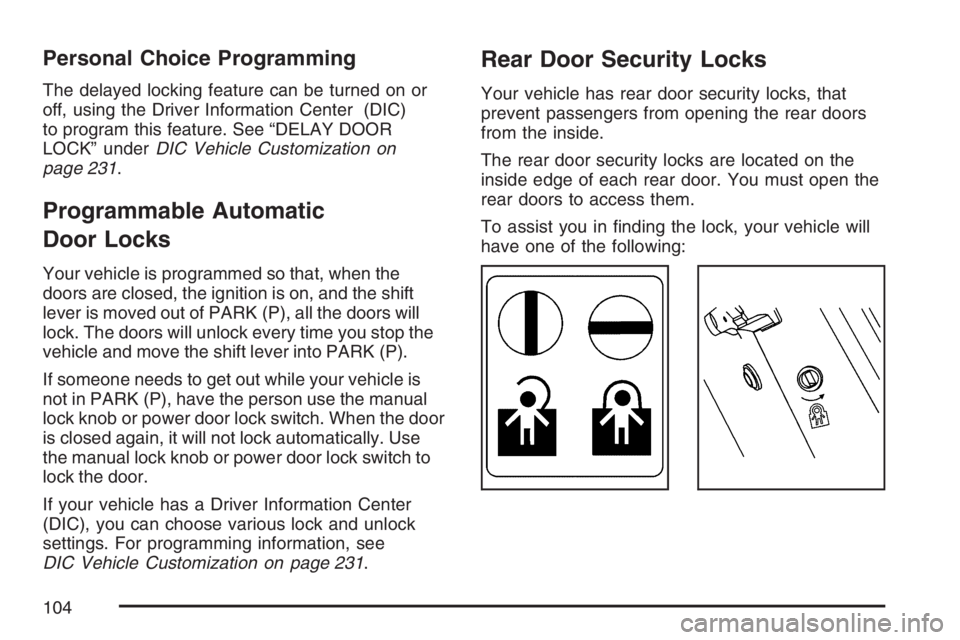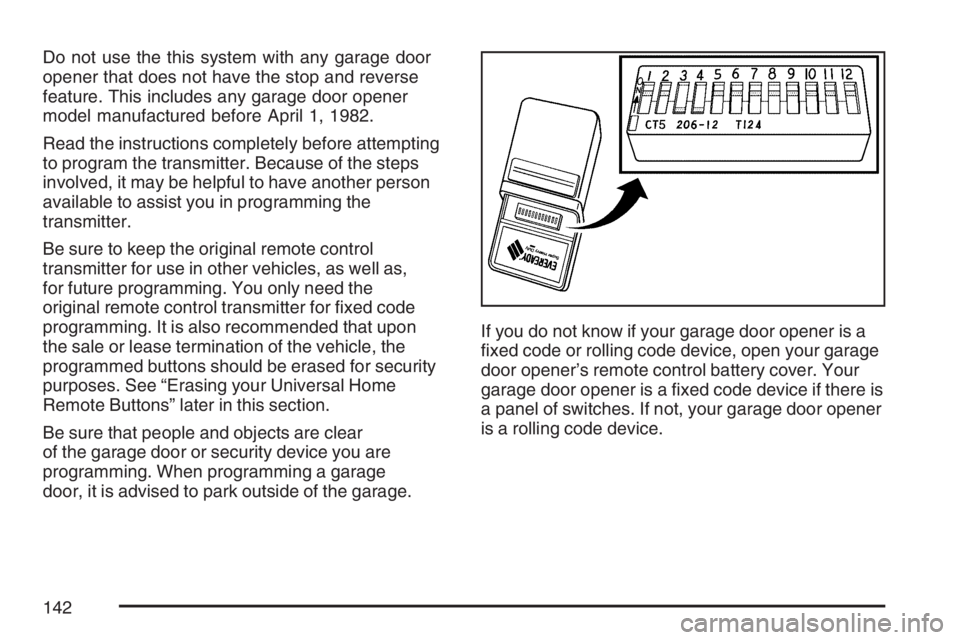2007 BUICK LUCERNE park assist
[x] Cancel search: park assistPage 91 of 496

Keys.............................................................. 93
Remote Keyless Entry (RKE) System.......... 94
Remote Keyless Entry (RKE) System
Operation................................................. 95
Doors and Locks........................................ 102
Door Locks................................................ 102
Power Door Locks..................................... 103
Delayed Locking........................................ 103
Programmable Automatic Door Locks........ 104
Rear Door Security Locks......................... 104
Lockout Protection..................................... 105
Trunk........................................................ 106
Windows...................................................... 108
Power Windows........................................ 109
Sun Visors................................................ 109
Theft-Deterrent Systems............................. 110
Content Theft-Deterrent............................. 110
PASS-Key
®III+......................................... 111
PASS-Key®III+ Operation......................... 112
Starting and Operating Your Vehicle......... 113
New Vehicle Break-In................................ 113
Ignition Positions....................................... 114
Retained Accessory Power (RAP)............. 115Starting the Engine.................................... 116
Engine Coolant Heater.............................. 117
Automatic Transaxle Operation.................. 119
Parking Brake........................................... 122
Shifting Into Park (P) ................................. 123
Shifting Out of Park (P)............................. 125
Parking Over Things That Burn................. 126
Engine Exhaust......................................... 127
Running the Engine While Parked............. 128
Mirrors......................................................... 129
Manual Rearview Mirror............................. 129
Manual Rearview Mirror with OnStar
®....... 129
Automatic Dimming Rearview Mirror
with OnStar
®.......................................... 129
Automatic Dimming Rearview Mirror with
OnStar
®and Compass........................... 130
Automatic Dimming Rearview Mirror
with Compass........................................ 132
Outside Power Mirrors............................... 133
Outside Curb View Assist Mirror................ 134
Outside Convex Mirror............................... 134
Outside Automatic Dimming
Heated Mirror......................................... 135
OnStar
®System.......................................... 135
Section 2 Features and Controls
91
Page 104 of 496

Personal Choice Programming
The delayed locking feature can be turned on or
off, using the Driver Information Center (DIC)
to program this feature. See “DELAY DOOR
LOCK” underDIC Vehicle Customization on
page 231.
Programmable Automatic
Door Locks
Your vehicle is programmed so that, when the
doors are closed, the ignition is on, and the shift
lever is moved out of PARK (P), all the doors will
lock. The doors will unlock every time you stop the
vehicle and move the shift lever into PARK (P).
If someone needs to get out while your vehicle is
not in PARK (P), have the person use the manual
lock knob or power door lock switch. When the door
is closed again, it will not lock automatically. Use
the manual lock knob or power door lock switch to
lock the door.
If your vehicle has a Driver Information Center
(DIC), you can choose various lock and unlock
settings. For programming information, see
DIC Vehicle Customization on page 231.
Rear Door Security Locks
Your vehicle has rear door security locks, that
prevent passengers from opening the rear doors
from the inside.
The rear door security locks are located on the
inside edge of each rear door. You must open the
rear doors to access them.
To assist you in �nding the lock, your vehicle will
have one of the following:
104
Page 116 of 496

Starting the Engine
Place the transaxle in the proper gear.
Move your shift lever to PARK (P) or
NEUTRAL (N). Your engine will not start in
any other position — this is a safety feature.
To restart when you are already moving,
use NEUTRAL (N) only.
Notice:Shifting into PARK (P) with the vehicle
moving could damage the transaxle. Shift
into PARK (P) only when your vehicle is
stopped.
Starting Procedure
1. With your foot off the accelerator pedal, turn
the ignition key to START. When the engine
starts, let go of the key. The idle speed will
go down as your engine gets warm. Do
not race the engine immediately after starting
it. Operate the engine and transaxle gently
to allow the oil to warm up and lubricate
all moving parts.Your vehicle has a Computer-Controlled
Cranking System. This feature assists in
starting the engine and protects components. If
the ignition key is turned to the START position,
and then released when the engine begins
cranking, the engine will continue cranking for
a few seconds or until the vehicle starts. If the
engine does not start and the key is held in
START for many seconds, cranking will be
stopped after 15 seconds to prevent cranking
motor damage. To prevent gear damage, this
system also prevents cranking if the engine is
already running. Engine cranking can be
stopped by turning the ignition switch to
the ACCESSORY or OFF position.
Notice:Cranking the engine for long periods
of time, by returning the key to the START
position immediately after cranking has ended,
can overheat and damage the cranking
motor, and drain the battery. Wait at least
15 seconds between each try, to allow
the cranking motor to cool down.
116
Page 134 of 496

Outside Curb View Assist Mirror
If your vehicle is equipped with memory mirrors, it
will also be capable of performing the curb view
assist mirror feature. This feature will allow the
driver’s and passenger’s side mirror to tilt to a
factory programmed position when the vehicle
is in REVERSE (R). This feature may be useful in
allowing you to view the curb when you are parallel
parking.
When the vehicle is shifted out of REVERSE (R)
or the ignition is turned to off, the driver’s and
passenger’s side mirror will return to its original
position.
SeeDIC Vehicle Customization on page 231for
more information.
Outside Convex Mirror
The passenger’s side mirror is convex. A convex
mirror’s surface is curved so more can be
seen from the driver’s seat.
{CAUTION:
A convex mirror can make things (like
other vehicles) look farther away than
they really are. If you cut too sharply into
the right lane, you could hit a vehicle on
your right. Check your inside mirror or
glance over your shoulder before
changing lanes.
134
Page 142 of 496

Do not use the this system with any garage door
opener that does not have the stop and reverse
feature. This includes any garage door opener
model manufactured before April 1, 1982.
Read the instructions completely before attempting
to program the transmitter. Because of the steps
involved, it may be helpful to have another person
available to assist you in programming the
transmitter.
Be sure to keep the original remote control
transmitter for use in other vehicles, as well as,
for future programming. You only need the
original remote control transmitter for �xed code
programming. It is also recommended that upon
the sale or lease termination of the vehicle, the
programmed buttons should be erased for security
purposes. See “Erasing your Universal Home
Remote Buttons” later in this section.
Be sure that people and objects are clear
of the garage door or security device you are
programming. When programming a garage
door, it is advised to park outside of the garage.If you do not know if your garage door opener is a
�xed code or rolling code device, open your garage
door opener’s remote control battery cover. Your
garage door opener is a �xed code device if there is
a panel of switches. If not, your garage door opener
is a rolling code device.
142
Page 147 of 496

Universal Home Remote
System Operation
(With One Triangular LED)
Your vehicle may have the Universal Home Remote
System. If there is one triangular Light Emitting
Diode (LED) above the Universal Home Remote
buttons, follow the instructions below. If your
vehicle has three round LED above the Universal
Home Remote buttons, follow the instructions under
Universal Home Remote System Operation (with
three round LED).
Do not use the Universal Home Remote with any
garage door opener that does not have the stop
and reverse feature. This includes any garage door
opener model manufactured before April 1, 1982.If you have a newer garage door opener with rolling
codes, please be sure to follow Steps 6 through 8 to
complete the programming of your Universal Home
Remote Transmitter.
Read the instructions completely before attempting
to program the Universal Home Remote. Because
of the steps involved, it may be helpful to have
another person available to assist you in the
programming steps.
Keep the original hand-held transmitter for use in
other vehicles as well as for future Universal Home
Remote programming. It is also recommended that
upon the sale of the vehicle, the programmed
Universal Home Remote buttons should be erased
for security purposes. See “Erasing Universal
Home Remote Buttons” later in this section or, for
assistance, seeCustomer Assistance Offices on
page 464.
Be sure that people and objects are clear of the
garage door or gate operator you are programming.
When programming a garage door, it is advised to
park outside of the garage.
It is recommended that a new battery be installed in
your hand-held transmitter for quicker and more
accurate transmission of the radio-frequency signal.
147
Page 155 of 496

Instrument Panel Overview........................ 158
Hazard Warning Flashers.......................... 160
Other Warning Devices............................. 160
Horn.......................................................... 160
Tilt Wheel.................................................. 161
Heated Steering Wheel............................. 161
Turn Signal/Multifunction Lever.................. 162
Turn and Lane-Change Signals................. 162
Headlamp High/Low-Beam Changer.......... 163
Flash-to-Pass............................................ 164
Windshield Wipers..................................... 164
Rainsense™ II Wipers............................... 165
Windshield Washer.................................... 166
Cruise Control........................................... 167
Exterior Lamps.......................................... 170
Wiper Activated Headlamps....................... 171
Headlamps on Reminder........................... 171
Daytime Running Lamps (DRL)................. 172
Fog Lamps................................................ 173
Cornering Lamps....................................... 173
Exterior Lighting Battery Saver.................. 173
Instrument Panel Brightness...................... 174
Courtesy Lamps........................................ 174
Entry Lighting............................................ 174Delayed Entry Lighting.............................. 174
Theater Dimming....................................... 175
Delayed Exit Lighting ................................. 175
Perimeter Lighting..................................... 175
Front Reading Lamps................................ 175
Electric Power Management...................... 176
Inadvertent Power Battery Saver............... 177
Battery Run-Down Protection..................... 177
Ultrasonic Rear Parking Assist (URPA)...... 178
Accessory Power Outlet(s)........................ 181
Ashtray(s) and Cigarette Lighter................ 182
Climate Controls......................................... 182
Climate Control System............................. 182
Dual Automatic Climate Control System.... 186
Outlet Adjustment...................................... 192
Passenger Compartment Air Filter............. 192
Warning Lights, Gages, and Indicators..... 194
Instrument Panel Cluster........................... 194
Speedometer and Odometer...................... 196
Trip Odometer........................................... 196
Tachometer............................................... 196
Safety Belt Reminder Light........................ 196
Section 3 Instrument Panel
155
Page 178 of 496

Ultrasonic Rear Parking
Assist (URPA)
If your vehicle is equipped, the Ultrasonic Rear
Parking Assist (URPA) system is designed to help
you park while in REVERSE (R). It operates only at
speeds less than 5 mph (8 km/h). URPA helps
make parking easier and helps you avoid colliding
with objects such as parked vehicles. The URPA
system detects objects that are close to the rear of
the vehicle which are at least 10 inches (25.4 cm)
off the ground and below hood or trunk level. The
system detects objects up to 8 feet (2.5 m) behind
your vehicle. URPA determines how close these
objects are from your bumper within this area.
Ultrasonic sensors on the rear bumper are used
to detect the distance to the object.
{CAUTION:
The Ultrasonic Rear Park Assist (URPA)
system does not replace driver vision.
URPA does not:
Operate above speeds of
5 mph (8 km/h).
Detect objects more than 8 feet
(2.5 meters) behind the vehicle. This
distance may be less during warmer or
humid weather.
Detect objects that are below the
bumper, underneath the vehicle,
or that are very close to the vehicle.
Detect children, pedestrians, bicyclists,
or pets.
So if you do not use proper care before
backing up, you could hit a vehicle, child,
pedestrian, bicyclist, or pet, resulting in
vehicle damage, injury, or death. Even
though the vehicle has the URPA system,
always check carefully before backing up
by checking behind your vehicle.
178